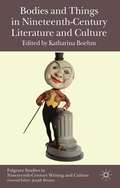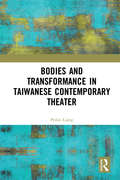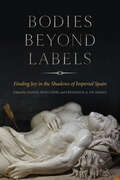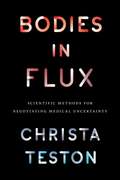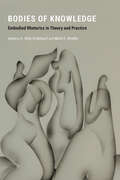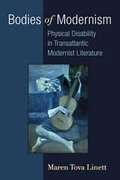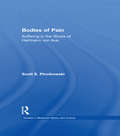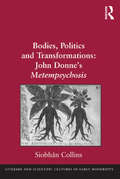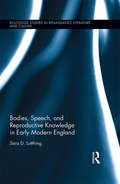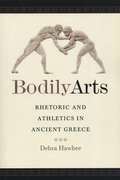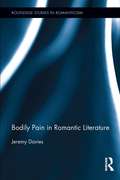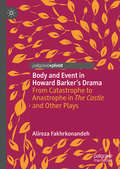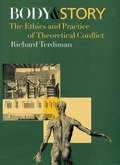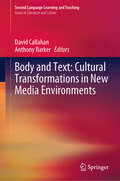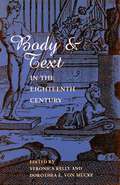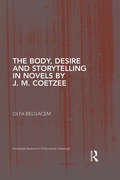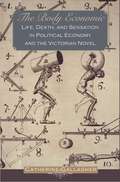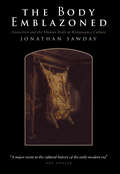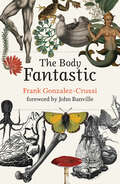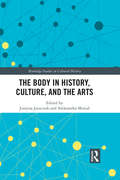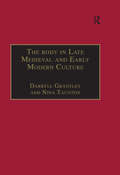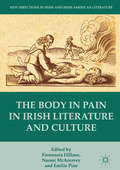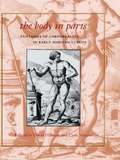- Table View
- List View
Bodies and Things in Nineteenth-Century Literature and Culture
by Katharina BoehmThis book provides fresh perspectives on the object world, embodied experience and materiality in nineteenth-century literature and culture. Contributors explore canonical works by Austen, Brontë, Dickens and James, alongside less-familiar texts and a range of objects including nineteenth-century automata, scrapbooks, museum exhibits and antiques.
Bodies and Transformance in Taiwanese Contemporary Theater
by Peilin LiangIn Bodies and Transformance in Taiwanese Contemporary Theater, Peilin Liang develops a theory of bodily transformation. Proposing the concept of transformance, a conscious and rigorous process of self-cultivation toward a reconceptualized body, Liang shows how theater practitioners of minoritized cultures adopt transformance as a strategy to counteract the embodied practices of ideological and economic hegemony. This book observes key Taiwanese contemporary theater practitioners at work in forging five reconceptualized bodies: the energized, the rhythmic, the ritualized, the joyous, and the (re)productive. By focusing on the development of transformance between the years of 2000–2008, a tumultuous political watershed in Taiwan’s history, the author succeeds in bridging postcolonialism and interculturalism in her conceptual framework. Ideal for scholars of Asian and postcolonial theater, Bodies and Transformance in Taiwanese Contemporary Theater shows how transformance, rather than performance, calibrates with far greater precision and acuity the state of the body and the culture that it seeks to create.
Bodies beyond Labels: Finding Joy in the Shadows of Imperial Spain (Toronto Iberic)
by Daniel Holcombe Frederick A. De ArmasBodies beyond Labels explores moments of joy and joyful expressions of self-identity, intimacy, sexuality, affect, friendship, social relationships, and religiosity in imperial Spanish cultures, a period when embodiments of such joy were shadowed by comparatively more constrictive social conventions. Viewed in this manner, joy frames historic references to gender, sexuality, and present-day concepts of queerness through homoeroticism, non-labelled bodies, gender fluidity, and performativity. This collection reveals diverse glimmers of joy through a variety of genres, including plays, poems, novels, autobiographies, biblical narratives, and civil law texts, among others. The book is divided into five categories: theatrical works that use mythology to enjoy themes of homoeroticism; narrative prose and visual arts that reveal public and private homoerotic expressions; scopophilia within garden and museum spaces that make possible joyous observations of non-labelled and non-corporeal bodies; biblical narratives and epistolary works that signal religious transgressions of gender and friendship; and sexual geographies explored in historic and legal documents. As new generations develop more nuanced senses of gender and sexual identities, Bodies beyond Labels strives to provide new academic optics, as framed by non-labelled bodies, queer theorizations, joy in unexpected places, and the light that has historically (re)emerged from the shadows.
Bodies Fins and Stripes (Reach Into Phonics Ser.)
by Dee Wallis Kelsey Bruce Deborah J. ShortNIMAC-sourced textbook
Bodies in Flux: Scientific Methods for Negotiating Medical Uncertainty
by Christa TestonDoctors, scientists, and patients have long grappled with the dubious nature of “certainty” in medical practice. To help navigate the chaos caused by ongoing bodily change we rely on scientific reductions and deductions. We take what we know now and make best guesses about what will be. But bodies in flux always outpace the human gaze. Particularly in cancer care, processes deep within our bodies are at work long before we even know where to look. In the face of constant biological and technological change, how do medical professionals ultimately make decisions about care? Bodies in Flux explores the inventive ways humans and nonhumans work together to manufacture medical evidence. Each chapter draws on rhetorical theory to investigate a specific scientific method for negotiating medical uncertainty in cancer care, including evidential visualization, assessment, synthesis, and computation. Case studies unveil how doctors rely on visuals when deliberating about a patient’s treatment options, how members of the FDA use inferential statistics to predict a drug’s effectiveness, how researchers synthesize hundreds of clinical trials into a single evidence-based recommendation, and how genetic testing companies compute and commoditize human health. Teston concludes by advocating for an ethic of care that pushes back against the fetishization of certainty—an ethic of care that honors human fragility and bodily flux.
Bodies in Flux: Scientific Methods for Negotiating Medical Uncertainty
by Christa TestonDoctors, scientists, and patients have long grappled with the dubious nature of “certainty” in medical practice. To help navigate the chaos caused by ongoing bodily change we rely on scientific reductions and deductions. We take what we know now and make best guesses about what will be. But bodies in flux always outpace the human gaze. Particularly in cancer care, processes deep within our bodies are at work long before we even know where to look. In the face of constant biological and technological change, how do medical professionals ultimately make decisions about care? Bodies in Flux explores the inventive ways humans and nonhumans work together to manufacture medical evidence. Each chapter draws on rhetorical theory to investigate a specific scientific method for negotiating medical uncertainty in cancer care, including evidential visualization, assessment, synthesis, and computation. Case studies unveil how doctors rely on visuals when deliberating about a patient’s treatment options, how members of the FDA use inferential statistics to predict a drug’s effectiveness, how researchers synthesize hundreds of clinical trials into a single evidence-based recommendation, and how genetic testing companies compute and commoditize human health. Teston concludes by advocating for an ethic of care that pushes back against the fetishization of certainty—an ethic of care that honors human fragility and bodily flux.
Bodies of Knowledge: Embodied Rhetorics in Theory and Practice
by A. Abby Knoblauch Marie E. MoellerBodies of Knowledge challenges homogenizing (mis)understandings of knowledge construction and provides a complex discussion of what happens when we do not attend to embodied rhetorical theories and practices. Because language is always a reflection of culture, to attempt to erase language and knowledge practices that reflect minoritized and historically excluded cultural experiences obscures the legitimacy of such experiences both within and outside the academy. The pieces in Bodies of Knowledge draw explicit attention to the impact of the body on text, the impact of the body in text, the impact of the body as text, and the impact of the body upon textual production. The contributors investigate embodied rhetorics through the lenses of race and ethnicity, gender and sexuality, disability and pain, technologies and ecologies, clothing and performance, and scent, silence, and touch. In doing so, they challenge the (false) notion that academic knowledge—that is, “real” knowledge—is disembodied and therefore presumed white, middle class, cis-het, able-bodied, and male. This collection lays bare how myriad bodies invent, construct, deliver, and experience the processes of knowledge building. Experts in the field of writing studies provide the necessary theoretical frameworks to better understand productive (and unproductive) uses of embodied rhetorics within the academy and in the larger social realm. To help meet the theoretical and pedagogical needs of the discipline, Bodies of Knowledge addresses embodied rhetorics and embodied writing more broadly though a rich, varied, and intersectional approach. These authors address larger questions around embodiment while considering the various impacts of the body on theories and practices of rhetoric and composition. Contributors: Scot Barnett, Margaret Booker, Katherine Bridgman, Sara DiCaglio, Kristie S. Fleckenstein, Vyshali Manivannan, Temptaous Mckoy, Julie Myatt, Julie Nelson, Ruth Osorio, Kate Pantelides, Caleb Pendygraft, Nadya Pittendrigh, Kellie Sharp-Hoskins, Anthony Stagliano, Megan Strom
Bodies of Modernism: Physical Disability in Transatlantic Modernist Literature
by Maren LinettBodies of Modernism brings a new and exciting analytical lens to modernist literature, that of critical disability studies. The book offers new readings of canonical and noncanonical writers from both sides of the Atlantic including Flannery O'Connor, Eudora Welty, H. G. Wells, D. H. Lawrence, Elizabeth Bowen, Henry Green, Olive Moore, Carson McCullers, Tennessee Williams, J. M. Synge, Florence Barclay, Virginia Woolf, and James Joyce. Through readings of this wide range of texts and with chapters focusing on mobility impairments, deafness, blindness, and deformity, the study reveals both modernism's skepticism about and dependence on fantasies of whole, "normal" bodies.
Bodies of Pain: Suffering in the Works of Hartmann von Aue (Studies in Medieval History and Culture #11)
by Scott E. PincikowskiFirst Published in 2002. Routledge is an imprint of Taylor & Francis, an informa company.
Bodies, Politics and Transformations: John Donne's Metempsychosis
by Siobhán CollinsSince the beginning of the twentieth century, critics have predominantly offered a negative estimate of John Donne’s Metempsychosis. In contrast, this study of Metempsychosis re-evaluates the poem as one of the most vital and energetic of Donne’s canon. Siobhán Collins appraises Metempsychosis for its extraordinary openness to and its inventive portrayal of conflict within identity. She situates this ludic verse as a text alert to and imbued with the Elizabethan fascination with the processes and properties of metamorphosis. Contesting the pervasive view that the poem is incomplete, this study illustrates how Metempsychosis is thematically linked with Donne’s other writings through its concern with the relationship between body and soul, and with temporality and transformation. Collins uses this genre-defying verse as a springboard to contribute significantly to our understanding of early modern concerns over the nature and borders of human identity, and the notion of selfhood as mutable and in process. Drawing on and contributing to recent scholarly work on the history of the body and on sexuality in the early modern period, Collins argues that Metempsychosis reveals the oft-violent processes of change involved in the author’s personal life and in the intellectual, religious and political environment of his time. She places the poem’s somatic representations of plants, beasts and humans within the context of early modern discourses: natural philosophy, medical, political and religious. Collins offers a far-reaching exploration of how Metempsychosis articulates philosophical inquiries that are central to early modern notions of self-identity and moral accountability, such as: the human capacity for autonomy; the place of the human in the ’great chain of being’; the relationship between cognition and embodiment, memory and selfhood; and the concept of wonder as a distinctly human phenomenon.
Bodies, Speech, and Reproductive Knowledge in Early Modern England (Routledge Studies in Renaissance Literature and Culture)
by Sara D. LuttfringThis volume examines early modern representations of women’s reproductive knowledge through new readings of plays, monstrous birth pamphlets, medical treatises, court records, histories, and more, which are often interpreted as depicting female reproductive bodies as passive, silenced objects of male control and critique. Luttfring argues instead that these texts represent women exercising epistemological control over reproduction through the stories they tell about their bodies and the ways they act these stories out, combining speech and physical performance into what Luttfring calls 'bodily narratives.' The power of these bodily narratives extends beyond knowledge of individual bodies to include the ways that women’s stories about reproduction shape the patriarchal identities of fathers, husbands, and kings. In the popular print and theater of early modern England, women’s bodies, women’s speech, and in particular women’s speech about their bodies perform socially constitutive work: constructing legible narratives of lineage and inheritance; making and unmaking political alliances; shaping local economies; and defining/delimiting male socio-political authority in medical, royal, familial, judicial, and economic contexts. This book joins growing critical discussion of how female reproductive bodies were used to represent socio-political concerns and will be of interest to students and scholars working in early modern literature and culture, women’s history, and the history of medicine.
Bodily Arts
by Debra HawheeThe role of athletics in ancient Greece extended well beyond the realms of kinesiology, competition, and entertainment. In teaching and philosophy, athletic practices overlapped with rhetorical ones and formed a shared mode of knowledge production. Bodily Arts examines this intriguing intersection, offering an important context for understanding the attitudes of ancient Greeks toward themselves and their environment. In classical society, rhetoric was an activity, one that was in essence "performed. " Detailing how athletics came to be rhetoric's "twin art" in the bodily aspects of learning and performance, Bodily Arts draws on diverse orators and philosophers such as Isocrates, Demosthenes, and Plato, as well as medical treatises and a wealth of artifacts from the time, including statues and vases. Debra Hawhee's insightful study spotlights the notion of a classical gymnasium as the location for a habitual "mingling" of athletic and rhetorical performances, and the use of ancient athletic instruction to create rhetorical training based on rhythm, repetition, and response. Presenting her data against the backdrop of a broad cultural perspective rather than a narrow disciplinary one, Hawhee presents a pioneering interpretation of Greek civilization from the sixth, fifth, and fourth centuries BCE by observing its citizens in action.
Bodily Pain in Romantic Literature (Routledge Studies in Romanticism)
by Jeremy DaviesShortlisted for the University English Early Career Book Prize 2016 Shortlisted for the British Association for Romantic Studies First Book Prize 2015 When writers of the late eighteenth and early nineteenth centuries explored the implications of organic and emotional sensitivity, the pain of the body gave rise to unsettling but irresistible questions. Urged on by some of their most deeply felt preoccupations – and in the case of figures like Coleridge and P. B. Shelley, by their own experiences of chronic pain – many writers found themselves drawn to the imaginative scrutiny of bodies in extremis. Bodily Pain in Romantic Literature reveals the significance of physical hurt for the poetry, philosophy, and medicine of the Romantic period. This study looks back to eighteenth-century medical controversies that made pain central to discussions about the nature of life, and forward to the birth of surgical anaesthesia in 1846. It examines why Jeremy Bentham wrote in defence of torture, and how pain sparked the imagination of thinkers from Adam Smith to the Marquis de Sade. Jeremy Davies brings to bear on Romantic studies the fascinating recent work in the medical humanities that offers a fresh understanding of bodily hurt, and shows how pain could prompt new ways of thinking about politics, ethics, and identity.
Body and Event in Howard Barker's Drama: From Catastrophe to Anastrophe in The Castle and Other Plays
by Alireza FakhrkonandehThis book explores questions of gender, desire, embodiment, and language in Barker’s oeuvre. With The Castle as a focal point, the scope extends considerably beyond this play to incorporate analysis and exploration of the Theatre of Catastrophe; questions of gender, subjectivity and desire; God/religion; aesthetics of the self; autonomy-heteronomy; ethics; and the relation between political and libidinal economy, at stake in 20 other plays by Barker (including Rome, The Power of the Dog, The Bite of the Night, Judith, Possibilities, I Saw Myself, Fence in Its Thousandth Year, The Gaoler’s Ache for the Nearly Dead, The Brilliance of the Servant, Golgo, among others).
Body and Story: The Ethics and Practice of Theoretical Conflict
by Richard TerdimanIn Body and Story, Richard Terdiman explores the tension between what might seem to be two fundamentally different ways of understanding the world: as physical reality and as representation in language. In demonstrating the complicated relationship between these two modes of being, he also presents a new bold approach to the problem of conflicts between irreconcilable but equally compelling theoretical ideas. Enlightenment rationalism is most often understood as maintaining that words can meaningfully refer to and grasp things in the material world, while Postmodernism famously argues that nothing exists outside of language. Terdiman challenges this clean distinction, finding the early seeds of Postmodern doubt in the Enlightenment, and demonstrating the stubborn resistance of material reality—particularly that of the body—to language even today. Building on readings of works by 18th-century encyclopedist Denis Diderot and contemporary philosopher-icon Jacques Derrida, Terdiman argues that despite their genuine and profound opposition, a constant negotiation or mutual interrogation has always been taking place between these two world-views, even as the balance at times shifts to one side or the other. In analyzing these shifts he proposes a new model for understanding how seemingly unabridgeable theories legitimately coexist in our intellectual conception of the world, and he suggests a new ethics for managing this coexistence.
Body and Text: Cultural Transformations in New Media Environments (Second Language Learning and Teaching)
by David Callahan Anthony BarkerThis book presents a collection of academic essays that take a fresh look at content and body transformation in the new media, highlighting how old hierarchies and canons of analysis must be revised. The movement of narratives and characterisations across forms, conventionally understood as adaptation, has commonly involved high-status classical forms (drama, epic, novel) being transformed into recorded and broadcast media (film, radio and television), or from the older recorded media to the newer ones. The advent of convergent digital platforms has further transformed hierarchies, and the formation of global conglomerates has created the commercial conditions for ever more lucrative exchanges between different media. Now source texts can move in any direction and take up any configuration, as emerging interacting fan bases drive innovation and new creative and commercial possibilities are deployed. Moreover, transformation may be not just a technology-driven creative practice and response, but at the very centre of the thematic worlds developed in those forms of story-telling which are currently popular: television series, video games, films and novels. The magic transformation of “your” money into “their” money is paralleled in contemporary media and culture by the centrality of transformation of one product to another as a media industry practice, as well as the transformation of bodies as a major theme both in the ensuing media products and in people’s identity practices in daily life.
Body and Text in the Eighteenth Century
by Veronica KellyTwelve scholars from the fields of English, French, and German literature here examine the complex ways in which the human body becomes the privileged semiotic model through which eighteenth-century culture defines its political and conceptual centers. In making clear that the deployment of the body varies tremendously depending on what is meant by the 'human body', the essays draw on popular literature, poetics and aesthetics, garden architecture, physiognomy, beauty manuals, pornography and philosophy, as well as on canonical works in the genres of the novel and the drama.
The Body, Desire and Storytelling in Novels by J. M. Coetzee (Routledge Research In Postcolonial Literatures Ser.)
by Olfa BelgacemAsserting that Coetzee’s representation of the body as subject to dismemberment counters the colonial representation of the other’s body as exotic and erotically-charged, this study inspects the ambivalence pertaining to Coetzee’s embodied representation of the other and reveals the risks that come with such contrapuntal reiteration. Through the study of the narrative identity of the colonial other and her/his body’s representation, the book also unveils the author’s own authorial identity exposed through the repetitive narrative patterns and characterization choices.
The Body Economic: Life, Death, and Sensation in Political Economy and the Victorian Novel
by Catherine GallagherThe Body Economic revises the intellectual history of nineteenth-century Britain by demonstrating that political economists and the writers who often presented themselves as their literary antagonists actually held most of their basic social assumptions in common. Catherine Gallagher demonstrates that political economists and their Romantic and early-Victorian critics jointly relocated the idea of value from the realm of transcendent spirituality to that of organic "life," making human sensations--especially pleasure and pain--the sources and signs of that value. Classical political economy, this book shows, was not a mechanical ideology but a form of nineteenth-century organicism, which put the body and its feelings at the center of its theories, and neoclassical economics built itself even more self-consciously on physiological premises. The Body Economic explains how these shared views of life, death, and sensation helped shape and were modified by the two most important Victorian novelists: Charles Dickens and George Eliot. It reveals how political economists interacted crucially with the life sciences of the nineteenth century--especially with psychophysiology and anthropology--producing the intellectual world that nurtured not only George Eliot's realism but also turn-of-the-century literary modernism.
The Body Emblazoned: Dissection and the Human Body in Renaissance Culture
by Jonathan SawdayAn outstanding piece of scholarship and a fascinating read, The Body Emblazoned is a compelling study of the culture of dissection the English Renaissance, which informed intellectual enquiry in Europe for nearly two hundred years. In this outstanding work, Jonathan Sawday explores the dark, morbid eroticism of the Renaissance anatomy theatre, and relates it to not only the great monuments of Renaissance art, but to the very foundation of the modern idea of knowledge. Though the dazzling displays of the exterior of the body in Renaissance literature and art have long been a subject of enquiry, The Body Emblazoned considers the interior of the body, and what it meant to men and women in early modern culture. A richly interdisciplinary work, The Body Emblazoned re-assesses modern understanding of the literature and culture of the Renaissance and its conceptualization of the body within the domains of the medical and moral, the cultural and political.
The Body Fantastic
by Frank Gonzalez-CrussiThe body in dreams, myths, legends, and anecdotes of the fantastic as expressions of human corporeality.In The Body Fantastic, Frank Gonzalez-Crussi looks at the human body through the lens of dreams, myths, legends, and anecdotes of the bizarre, exploring the close connection of the fictitious and the fabulous to our conception of the body. He chronicles, among other curious cases, the man who ate everything (including boiled hedgehogs and mice on toast), the therapeutic powers of saliva, hair that burst into flames, and an "amphibian man" who lived under water. Drawing on clinical records, popular lore, and art, history, and literature, Gonzalez-Crussi considers the body in both real and imaginary dimensions. Myths and stories, Gonzalez-Crussi reminds us, are the symbolic expression of our aspirations and emotions. These fantastic tales of bodies come from the deepest regions of the human psyche. Ancient Greeks, for example, believed that the uterus wandered around inside a woman's body--an "animal within an animal." If a woman sniffed an unpleasant odor, the uterus would retreat. Organized "digestive excess" began with the eating and drinking contests of antiquity and continue through the hot-dog eating competitions of today. And the "libido-podalic association," connecting male sexuality and the foot, insinuated itself into mainstream medicine in the sixteenth century; meanwhile, the feet of women in some cultures were scrupulously kept from view. Gonzalez-Crussi shows that the many imaginary representations of the body are very much a part of our corporeality.
The Body in History, Culture, and the Arts (Routledge Studies in Cultural History #72)
by Justyna Jajszczok Aleksandra MusiałThe aim of this book is to explore the body in various historical contexts and to take it as a point of departure for broader historiographical projects. The chapters in the volume present the ways in which the body constitutes a valuable and productive object of historical analysis, especially as a lens through which to trace histories of social, political, and cultural phenomena and processes. More specifically, the authors use the body as a tool for critical re-examination of particular histories of human experience, and of societal and cultural practices, thus contributing to the burgeoning area of body history in terms of both specific case studies as well as historiography in general.
The Body in Late Medieval and Early Modern Culture
by Nina TauntonTaking as its chronological starting-point the female body of late medieval devotional literature, the volume moves on to a consideration of the representation of gendered bodies in later literature. It then proceeds to examine sixteenth-century occupational orderings of the (male) body in education, the civil service and the army, and involves explorations into a variety of rituals for the purification, ordering and disciplining of the flesh. It includes enquiries into the miraculous royal body, demon bodies, the 'virtual' body of satire, and ends the late seventeenth century with dramatic representations of the diseased body, and the grotesque bodies of travellers’ tales as signifiers of racial difference. It pushes forward post-modern notions of the body as a site for competing discourses. It provides new dimensions to fantasies, rituals and regulations in narratives ('fictions') of the body as identifications of forms of knowledge unique to the early modern period. Each of the essays sheds new light on how these late medieval and early modern narratives function to produce specialized and discrete languages of the body that cannot be understood simply in terms, say, of religion, philosophy or physiology, but produce their own discrete forms of knowledge. Thus the essays materially contribute to an understanding of the relationship between the body and spatial knowledge by giving new bearings on epistemologies built upon pre-modern perceptions about bodily spaces and boundaries. They address these issues by analysing forms of knowledge constructed through regulations of the body, fantasies about extensions to the body and creations of bodily, psychic, intellectual and spiritual space. The essays pose important questions about how these epistemologies offer different investments of knowledge into structures of power. What constitutes these knowledges? What are the politics of corporeal spaces? In what forms of knowledge about spatial and bodily perceptions and p
The Body in Pain in Irish Literature and Culture
by Fionnuala Dillane Naomi Mcareavey Emilie PineThis book elucidates the ways the pained and suffering body has been registered and mobilized in specifically Irish contexts across more than four hundred years of literature and culture. There is no singular approach to what pain means: the material addressed in this collection covers diverse cultural forms, from reports of battles and executions to stage and screen representations of sexual violence, produced in response to different historical circumstances in terms that confirm our understanding of how pain - whether endured or inflicted, witnessed or remediated - is culturally coded. Pain is as open to ongoing redefinition as the Ireland that features in all of the essays gathered here. This collection offers new paradigms for understanding Ireland's literary and cultural history.
The Body in Parts: Fantasies of Corporeality in Early Modern Europe
by David Hillman Carla MazzioAn examination of how the body--its organs, limbs, and viscera--were represented in the literature and culture of early modern Europe. This provocative volume demonstrates, the symbolism of body parts challenge our assumptions about "the body" as a fundamental Renaissance image of self, society, and nation.
